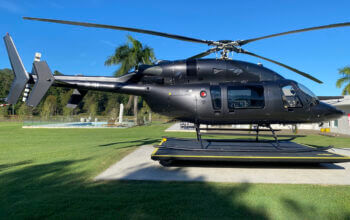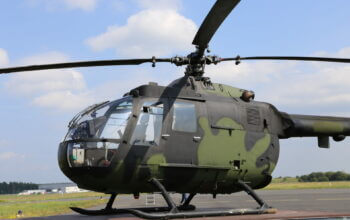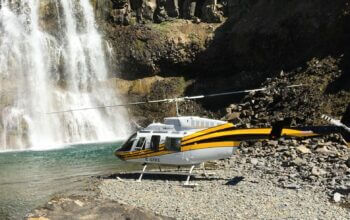Levitate Capital, a venture capital firm focused exclusively on drones and other new air mobility technology, released a white paper predicting logistics applications of drones and eVTOLs to dominate market growth between 2025 and 2030, with little commercial passenger service before the end of the decade.

“The [passenger eVTOL] market will take the longest to reach commercial viability. Some companies expect to start operations as early as 2023 . . . but we think the reality is that a truly scaled and sustainable operation will take much longer than that,” explained Levitate Capital senior associate Dario Constantine, the report’s primary author. “We think that will happen by the latter end of the decade, certainly starting in small scale by 2025.”
The report, a result of quantitative analysis and numerous industry conversations, expects the passenger eVTOL market to total just $2 billion by 2030 — a significantly lower estimate than released last year by Nexa Capital Advisors, which expects $244 billion in revenue from passenger flights between 2020 and 2040, 30 percent of which the firm projects will occur in the next decade.
Where Nexa and Levitate Capital’s projections diverge is in the timeline to introduction of eVTOL aircraft and associated services, with Nexa expecting billions in revenues globally before 2025 and Levitate Capital doubtful the Federal Aviation Administration will grant certifications for eVTOL aircraft that allow commercial human transport before 2026.
In the longer term, however, Levitate Capital — an investor in vehicle manufacturer Volocopter as well as eVTOL infrastructure companies Skyports and Chargepoint — does believe that passenger transportation will scale rapidly to become the largest segment of the drone economy, reaching $50 to $60 billion annually by 2040.
At that point, the firm’s report estimates eVTOL transportation will cost $0.22 per available seat mile by 2040, less than just about every mode of ground transportation — including Ubers, Taxis and personal car ownership — except for buses.

A report released last year by Citibank similarly cited industry estimates of $0.20-$0.40 per available seat mile for eVTOL air taxis by 2040, noting that pooling of autonomous road taxis may still provide cheaper services on the ground.
Bastiaan Janmaat, a managing partner at Levitate Capital, sees a few long-term trends working in favor of aerial mobility that may ultimately make eVTOLs even more favorable compared to ground transportation.
“One thing that could hold back improvements on the ground side is congestion, which is obviously getting worse and worse. Hopefully, technology can combat some of that as well, but ultimately that’s a long-term trend working against anything moving on the ground and will be less of a problem in the sky,” Janmaat said. “And autonomy, while it is being developed for large and small ground-based vehicles, is a much harder problem to solve than autonomy in the sky. There are just fewer things to hit, fewer edge cases and fewer participants around you. So it stands to reason that we’ll get to fully autonomous functionality in the air much, much sooner than on the ground.”
Before eVTOLs take off as a mode of transportation, Levitate Capital expects rapid growth in the enterprise drone market in the next five years, followed by widespread adoption of drones for logistics in the latter half of the decade as aircraft with larger payloads are certified and autonomous capabilities mature. The firm is an investor in Elroy Air, a developer of hybrid-electric autonomous aircraft for logistics purposes which recently won a Phase 3 Small Business Innovation Research contract from the U.S. Air Force, as well as drone manufacturers Matternet and Skydio.
“Logistics drones will likely become the largest sector of the drone economy by the end of the decade,” said Constantine during a discussion hosted by the Vertical Flight Society. “In 2019, the Pitney Bowes Parcel Shipping Index estimated about 100 billion parcels were shipped, and that will rise to about 200 billion parcels shipped by 2025 and 250 billion by 2030. Delivery drones will deliver a small portion of that — we think about 0.01 percent of parcels shipped in 2025 and roughly 1 percent in 2030.”
Three technology trends to watch, according to Levitate Capital, are autonomy, energy storage density and noise reduction, with improvements in all three necessary to enable drones and eVTOLs to provide useful logistics and transportation services affordably at scale.
“The best batteries today can currently achieve about 260 watt-hours per kilogram (Wh/kg),” Constantine said. “We think that can get towards 400 Wh/kg by 2025 and 500 Wh/kg by 2030, but not through improvements to lithium-ion batteries, which have improved by roughly five percent per year and seem to be peaking at around 300 Wh/kg.”
Two things attracted the firm to invest in Volocopter, according to Janmaat: the company’s rather quick path to certification due to the simplicity of its VoloCity eVTOL design, and an early emphasis on creating a logistics version of its aircraft — the VoloDrone — which Levitate Capital expects to find earlier applications autonomously delivering packages and spraying crops than the passenger version.
“As we look at other companies in the space, we have to believe that a company will be able to raise a billion dollars, because that’s roughly what it costs to get a company through certification to market,” said Janmaat, discussing how the firm is evaluating other potential investments in eVTOL developers. “That doesn’t have to all come from private investors — a lot of it could come from governments or early customers’ down payments, but those latter two are harder to count on, so the company has to have a pretty shrewd CEO in terms of fundraising capabilities.”








